My dog Remy is like many other dogs – he pulls hard on the leash!
I make sure to spend time training “heel” and loose-leash walking but it will always be a work in progress. I thought I’d share my tips on how to stop your dog from pulling.
Below are some of the tips that have worked with my strong puller.
If your dog pulls on the lead, just know that this is a very common problem and normal dog behavior.
How to stop your dog from pulling on the leash
It’s up to us to teach them not to pull – and it takes a lot of time, consistency and patience. So hang in there!
1. Find a collar that makes your dog’s pulling less extreme
As you know, people can get emotional and opinionated about training tools. You kind of have to ignore all that and use what works for you.
It truly doesn’t matter to me which training collar you prefer. It needs to be something that you are comfortable using and something that allows you to safely control your dog without hurting your dog.
Training collar options to minimize a dog’s pulling on the leash:
- Gentle Leader or Halti head collar
- No pull harness (leash clips to the front of the dog)
- Herm Sprenger prong collar
- Martingale collar (for less extreme pullers)
2. Use a specific collar for training and another for “fun” walks
Dogs are pretty good at recognizing specific “gear” for specific situations. I like using a training collar for training walks and a harness for our “fun” walks.
My own dog is a 63-pound weimaraner and he pulls hard if he can get away with it. For him, I prefer using either a Gentle Leader or a prong collar while we’re working on training.
We also have an EasyWalk no-pull harness that he wears on “fun” walks where we’re not working on training. For example, when I want to head out for an hour and just get exercise or hike on a trail.
This gives me some control but when he wears it I allow him to sniff and walk ahead of me.
I also recommend a six-foot leash vs. a retractable leash for all of your walks. My favorite leash is a simple 6-ft leather leash because it’s easier for me to grip than nylon and usually lasts years and years.
3. Use highly motivating treats!
To train your dog to stop your dog from pulling when you’re outside, you’ll need to use the best treats! Think hot dogs, cheese or jerky.
Indoors, dogs are less picky because there’s fewer distractions.
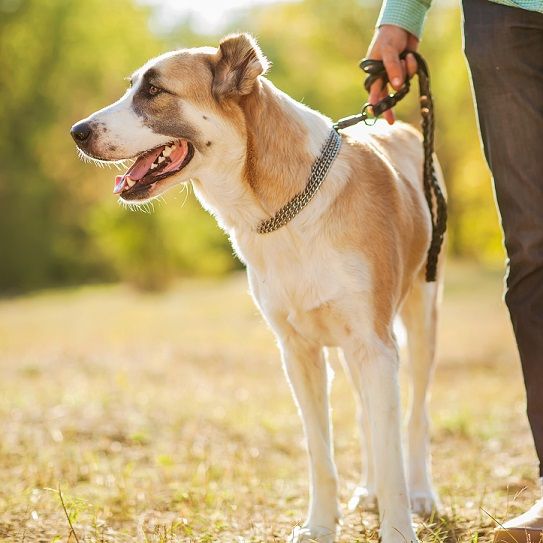
Outside, I use bits of deli meat, bits of cheese, soft treats and sometimes pieces of chicken. I mix it all together in a treat pouch and add in some dry dog food.
Total, I use about 1/2 cup of goodies per 20-min walk. Obviously, you might need to cut back on your dog’s meals if you do this.
3. Wear a treat pouch around your waist
At the very minimum, carry a TON of treats in your pockets.
Once you start heading out for training walks, you’re going to need to carry about a 1/2 cup’s worth of small treats. That probably won’t fit in your pockets easily.
A treat pouch fits around your waist (yep, like a fanny pack!) so you have quick access to treats. I walk with Remy and give him treat-treat-treat for walking at my side.
I can fit my whole hand in the pouch so treats are easily accessible at all times.
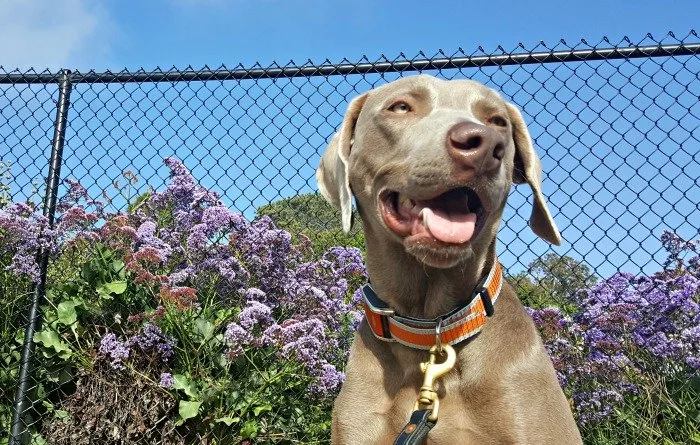
I reward Remy for looking at me, walking at my side and not pulling. I also use treats to lure him back when he pulls or gets ahead. I simply stop and wait for him to return or I lure him back.
4. Practice heeling indoors a lot
This is what really helped Remy. We worked in the living room for five minutes a day and it really clicked for him on the third day.
I used a leash at first and simply popped treats into his mouth for being at my left side or making eye contact. I walked along the wall so he had few options of where to go and lured him where I wanted him to be (my left side).

I would stop and have him sit, give a treat. Then take a step forward, have him sit, give a treat. Then two steps, etc. He really caught on quickly.
Practicing indoors is what made a huge difference for us because Remy seemed to finally “get” what I wanted and with no distractions it was easy for us to succeed.
Practice in every room of the house, the basement, the garage, perhaps the back yard or the driveway. I like to practice in quiet, open parking lots like church parking lots on weekday mornings.
5. Practice heeling on walks
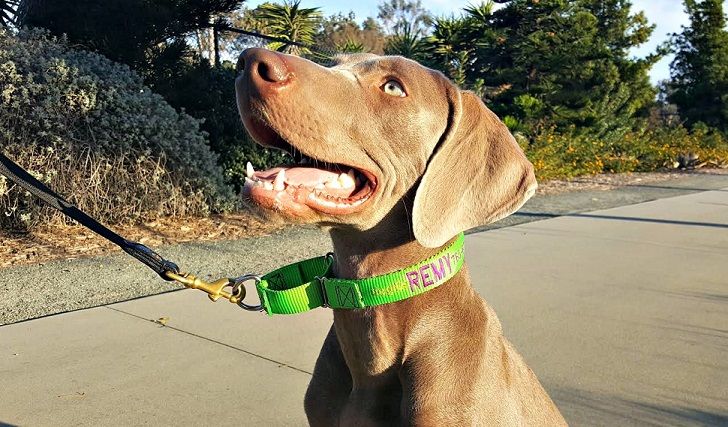
Of course, outdoors is the challenging part.
Our obedience instructor actually told me not to walk Remy for now if he’s going to pull. She said to stick to really boring walks up and down the driveway or in circles in the yard or perhaps down the street at quiet times.
She’s right.
If you want to stop your dog’s pulling you need to remove his opportunity to pull. Practicing indoors makes sense until he gets the hang of it. Then move on to “boring” outdoor areas before adding more exciting outdoor areas.
However, in the real world, I need to be able to walk weimaraner for exercise purposes and potty breaks. I don’t have a fenced yard. so a leash is his only access to the outdoors.
So … I am not perfect.
Sometimes I just need to get my dog out for a quick potty break and he pulls. This sets our training back. Sometimes I just want to be “normal” and check out from training … and he pulls. Like, really bad. This sets our training back.
This is why it’s helped me to use a specific collar for our training walks and a different harness for our “checked out” walks. I try to be consistent.
*Enjoying this article? Get realistic dog training tips emailed once a week. Click Here
6. Take a short break every 5 minutes during walks
This is really important.
On your walks, ask your dog to heel for 5 minutes or so, and then use your release word – “Free!” or “Break!” – to let him sniff or play or walk ahead for at least 30 seconds (but stop moving if he pulls).
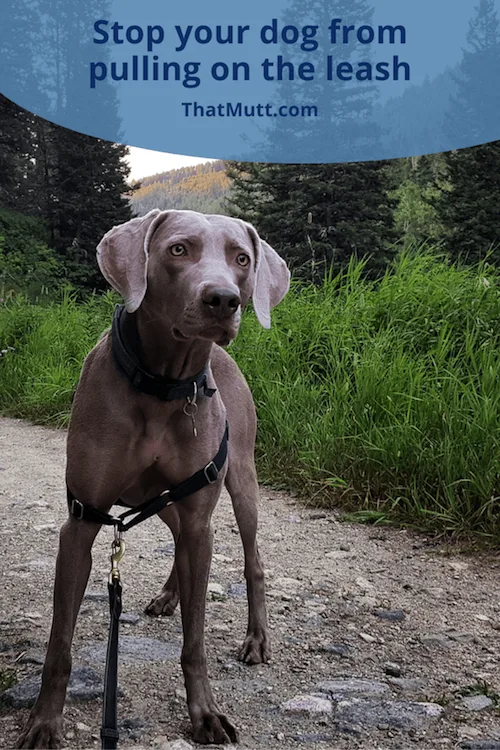
There are a few reasons for this:
- Dogs have short attention spans
- This helps remind you to take breaks and keep this fun!
- Heel is very, very difficult for them
- It helps if they understand “heel” means “heel until I release you.”
So, try rotating between focused heeling for 5 minutes, quick break, heeling for 5 minutes, quick break.
More tips to stop your dog from pulling
- Walk in zig-zags or figure-8s. Turn around a lot.
- Work on random obedience or obstacles.
- Pick up the pace, jog a little, run.
- Sign up for a basic obedience class.
- Try different types of treats!
- Try different training collars (prong collar, Gentle Leader, no pull harness, etc)
*Enjoying this article? Get realistic dog training tips emailed once a week. Click Here
Other helpful articles
- 13 tips for teaching heel (That Mutt)
- How to train loose-leash walking when your dog needs exercise (That Mutt)
- How to teach loose-leash walking (Dr. Patricia McConnell)
Get all of our training tips HERE
Lindsay Stordahl is the founder of That Mutt. She writes about dog training, dog exercise and feeding a healthy raw diet.
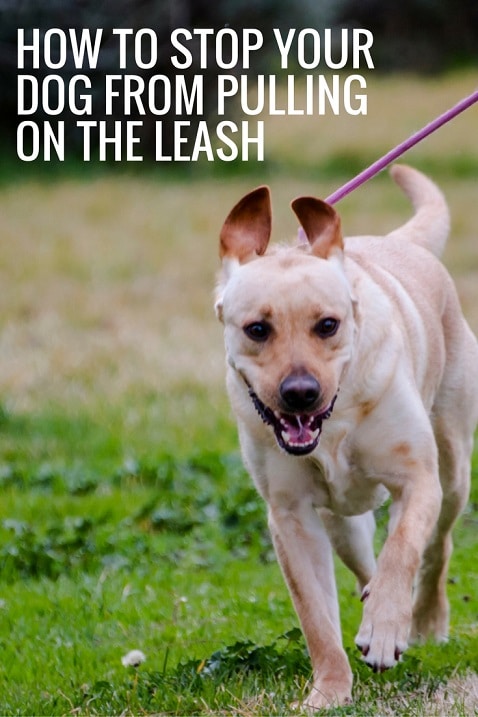

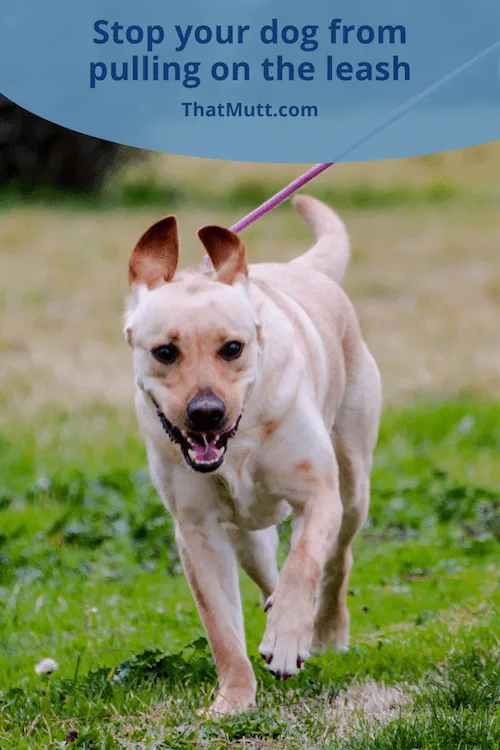
Katie O’Brien
Friday 27th of January 2023
Thank you so much for your blog, and for daring to discuss the occasional and strategic use of negative and physical corrections. In 35 years of loving and training big dogs, some have been sweethearts and some have been hardasses. All were eventually well-trained and reliable, but we definitely had to adjust our training methods to the temperament and behavior of the dog.
We had a wonderful high energy enthusiastic very dominant female Lab, who was easy to train for most things, but terrible on leash as a pup. Not that she lunged at dogs or anything…walking was just way too slow, and she was determined to help us go faster!
So we got a trainer to help us with “heel” and leash work. He did a couple of things that astonished me at the time, but were very effective.
The first was that he decided she needed to burn off a little energy first, so he threw her (actually he threw her ball) into what must be one of the coldest fastest moving urban rivers in North America. She was already a capable swimmer and retriever, but we had always taken her to a smaller slower moving stream to swim, so it was pretty surprising to see our dog looking so small in the big river, totally focused and closing in on the ball, as they both were swept downstream in the current. No problem…in a few minutes she was back with the ball and ready to go again. After 5 or 6 throws, the trainee was ready to be trained. And the owners had learned something too!
Next he put her on leash with a choke chain, and started walking. Of course she got out in front of him and started pulling. He jerked up with a modest correction, and she didn’t even pause. So he jerked upward with a mighty correction that made her yelp. This was hard to watch, but from that moment he had her complete attention, she walked perfectly at his side for the next 10 minutes. And she loved that guy from then on every time we saw him.
Of course we were able to do the same thing and get the same results. And each of us only had to do the really hard correction once, as if to show her we were serious about who was setting the pace, and what her position should be. She never stopped wanting to be in charge, but the choke chain helped her remember that on leash walks her job was to heel. (Besides structured leash walks, we also did lots of off-leash walks and wilderness hiking, and we had a friend who took her running, so leash walks were not her main form of exercise.)
Keep in mind we already knew this was no timid dog whose spirit would be crushed by a little tough discipline. She was a friendly fun loving energetic pup who grew into a smart, athletic, brave, well-mannered ambassador we could take almost everywhere. But the combination of intense exercise before focused training, and the use of a single hard correction to interrupt an unwanted behavior were elements we put to use many times in the future with our bigger tougher dogs.
Dog Training Recap & 2022 Goals! -
Tuesday 22nd of November 2022
[…] instance, I settle for Remy will pull on the leash (that’s why he’s nice at canicross!), so I simply use a no-pull harness once I want extra […]
Heather Vina
Friday 18th of November 2022
I am enjoying your blog. Great suggestions. I totally agree about using a different collar for different activities. My golden Augie is a therapy dog. We use the gentle leader for that and any situation I want a little more control. For his morning walks we use a regular collar and he is fine.
How It’s Going With Puppy Rip! - OrgBeTold
Tuesday 8th of November 2022
[…] are different methods to teaching a dog not to pull. I think it’s one of the hardest things to teach some […]
Dog’s First Pheasant Hunt | Weimaraner’s First Hunt - OrgBeTold
Monday 7th of November 2022
[…] Heel and stay are also very important but my dog does not heel when he’s amped up and I step on his check cord when I really need him to stay put. […]